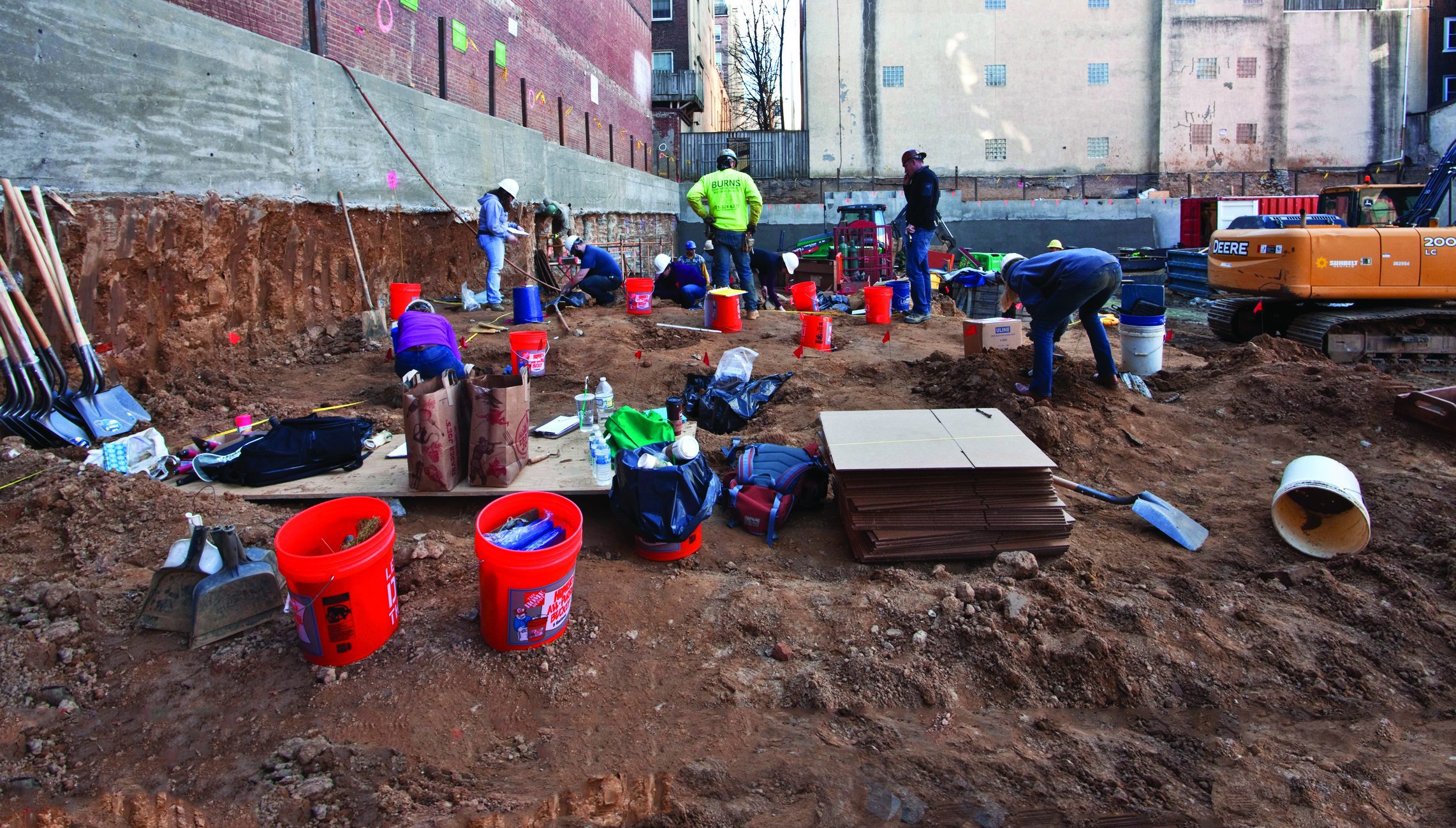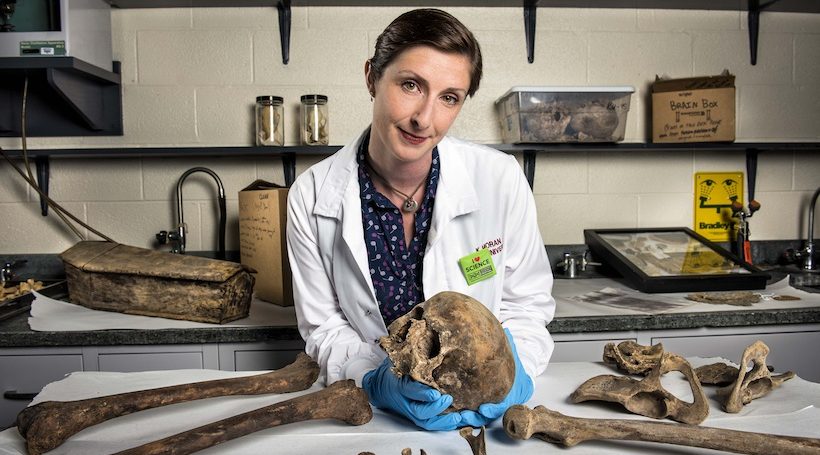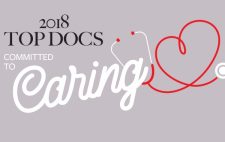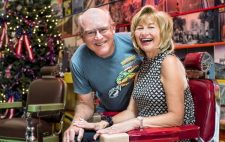
When Kimberlee Moran read about the bones, she had to get involved.
In late 2016, The Philadelphia Inquirer published a report about bones and gravestones being unearthed at an Old City construction site after an anonymous whistleblower reported the find to the police. For the average reader, it was a slightly disturbing story; for Moran, a professor and director of forensics at Rutgers University-Camden, it was a call to action.
While the local medical examiner and Historical Commission were working on the scene, Moran reached out to a friend at Philadelphia’s Mutter Museum, where an extensive collection of medical artifacts is housed for the American College of Physicians. Together they did some background research on the site, then contacted the developer and arranged to pick up what was then one cardboard box filled with bones.
Once Moran arrived at Arch Street, it became clear she was going to need more boxes.
Moran’s team toured the site and could see bones on the ground and in the large pile of back dirt. They filled a box rather easily and quickly.
A few weeks later, Moran was called back to the site. “More bones were turning up, and the site manager wasn’t sure what to do,” she says.
When Moran arrived, she found that the backhoe excavation had begun in the southwest corner of the site. “Bones were all over the ground surface and sticking out of the pile of back dirt. Two gaps in the wall of the remaining dirt were clearly visible – coffins with long bones inside of them.” The Arch Street Project had begun.
Moran explains that for 150 years, the people of colonial Philadelphia buried their dead in the cemetery of the First Baptist Church, which is now the site on Arch Street. The last burial there was in 1854, and the church moved to a larger building closer to downtown.
With no one to tend to the cemetery, it fell into disrepair, becoming a garbage dump for the surrounding neighborhood. In 1860, the coffins and their contents were relocated across the city.
And that was that. A hat factory was built on the site soon after, and over the next 150 years, the location was home to other factories and a car repair shop. A few years ago, the land was sold to a private developer, and a crew started digging a subterranean parking garage. When they found the first bones, everyone realized there were gaps in the history.
Moran says her team has since figured out exactly what happened.
“The city gave authorization to move the cemetery on January 1, 1860,” she says. “But it had to be finished by April 1, 1860. So they had three months, in the middle of winter, to move more than 1,000 people using 19th-century technology. They did the best they could.”
In fact, there were almost 500 burials – at least – left behind, and eventually, Moran’s team was granted permission to excavate the site. They had a week in the middle of a March 2017 snowstorm, but they managed to uncover and catalogue at least 83 individuals.
But it still wasn’t over. “Almost immediately after we left, they started uncovering new burials,” Moran says.
“Another whistleblower went to the newspaper and brought them some photos. The Inquirer sent the photos to us, and I knew immediately they were recent, taken in the summertime.”
The developer agreed to allow an outside archeological firm access to the site, and they uncovered a staggering 328 gravesites. Today, there are 496 sets of remains in the labs of Moran and her team, whose work is only just beginning.
“The first major effort was making sure everything was out of the ground,” Moran says. “Then we had to excavate the intact coffins and take samples of everything: soil, wood, the nails that held it all together. That was last summer. Now we have to clean all the bones before we can do anything else.”
In addition to Moran, the Arch Street Project involves anthropologists, archeologists, osteologists, historians and countless undergraduate and graduate students, all of them volunteers. Amanda Gonzalez worked as a crime scene investigator specializing in DNA analysis before returning to Rutgers-Camden for a graduate degree. She took one of Moran’s classes – “Bones and Bioarcheology” – and has continued to volunteer her time to the Arch Street Project.
“I want people to be aware that finding remains like this is a learning opportunity,” Gonzalez says. “It isn’t a treasure hunt. There’s so much to learn about our colonial ancestors, from the diseases that were prominent at the time to the genetic defects that impacted children.”
Once the bones are cleaned, the team will take careful measurements, run tests and examine them for information about who these people were, how they lived and how they died. There have already been significant discoveries.
“We now have the largest collection of coffin hardware from this era ever,” Moran says. “And we’ve uncovered evidence of syphilis and tuberculosis in the soil. There’s actually a lot of preserved brain material, and the lipid biomarkers can tell us if someone had viral diseases or Alzheimer’s, or if they were pregnant when they died.”
Thanks to the refuse that was thrown into the cemetery during its days as a de-facto garbage heap, Moran says her team has learned other things, too.
“Because of the animal bones that are present, we know what they were eating,” she says. “Lots of mutton and lamb; some chicken and goose.”
The implications for what the remains could teach us about our colonial ancestors are limitless, largely thanks to the historic church’s policy surrounding who could be buried on Arch Street, says Moran.
“The Baptist cemetery was founded by Welsh and English people,” she says. “But later, the church was using it as a bit of a cash cow. They’d charge one price for congregants to be buried there and another price for what they called ‘strangers,’ but the result was that it became a total cross section of the Philadelphia community. We have Baptists, non-Baptists, rich and poor, young and old. It makes this really unique.”
By examining the coffin hardware, Gonzalez says, the researchers can tell the social status of an individual. “You can tell who the wealthy people were, compared to the people who lived more modestly, by looking at the wood and nails, and the metal the hardware is made of,” she says.
While the team’s historian has procured burial records for the site, including the names of at least 1,000 people, most of the remains haven’t been positively identified. “We have one individual named Benjamin Britton,” Moran says. “He had a plate on his coffin with his name. We’ve since found two other name plates, but don’t yet know which remains they belong to.”
Moran’s been contacted by a number of people who believe their ancestors are among the remains excavated from Arch Street and have volunteered for DNA testing. Moran says DNA testing would answer a lot of questions – if she and her team can find a way to pay for it.
“The problem with DNA testing is that it’s very expensive, and at the moment this project has a budget of $0,” she says.
“We’ve raised a little money through crowdfunding, but it all goes to toothbrushes and plastic and paper bags – the little things we need to do the cleaning. DNA tests can run $500 per test, plus another $500 for everyone who comes forward saying they think they’re a relative. But I’d love to do it, not just to connect relatives to their ancestors, but to match familial DNA among the remains. I’d like to bury people in their family groups – I think that’s what they probably wanted in the first place.”
The remains, as rich as they are in historical and scientific data, will be reburied, and to Moran, that part is just as important as the research.
“While we want all this information, they deserve to be put back to rest,” she says. “We don’t want to exploit these individuals. I work in the forensic space, and I deal with living people who’ve suffered the loss of a loved one. I’m very aware of the human aspect of death, and archeology has enough sins on its soul for things we’ve done to previous cultures in the name of science.”
The re-interment date is determined by the city’s Orphans Court, and Moran’s team has requested a deadline of September 30, 2023.
“That’ll be five years since the last burial came out of the ground,” Moran says. “Five years is not a lot of time for all the research we’d like to do, but ultimately, these remains need to be laid to rest. So right now, money and time are the problem.”
Gonzalez hopes support will come in the form of grants and contributions from a community that feels the same connection to the remains that she does.
“These aren’t just remains,” she says. “They’re people who lived at the beginning of the establishment of America. These were families who lived here not all that long ago, in the grand scheme of things, and all these scientists of different fields are working to put together a greater picture of what their lives looked like.”
“To learn about their past and our present and connect those things is a learning opportunity, but it’s also emotionally rooted. This project should have a deep meaning to anyone who’s from the Philadelphia area.”














